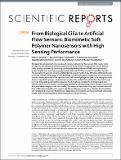From Biological Cilia to Artificial Flow Sensors: Biomimetic Soft Polymer Nanosensors with High Sensing Performance
Author(s)
Asadnia, Mohsen; Kottapalli, Ajay Giri Prakash; Karavitaki, K. Domenica; Warkiani, Majid Ebrahimi; Miao, Jianmin; Corey, David P.; Triantafyllou, Michael S; ... Show more Show less
DownloadFrom biological.pdf (1.651Mb)
PUBLISHER_CC
Publisher with Creative Commons License
Creative Commons Attribution
Terms of use
Metadata
Show full item recordAbstract
We report the development of a new class of miniature all-polymer flow sensors that closely mimic the intricate morphology of the mechanosensory ciliary bundles in biological hair cells. An artificial ciliary bundle is achieved by fabricating bundled polydimethylsiloxane (PDMS) micro-pillars with graded heights and electrospinning polyvinylidenefluoride (PVDF) piezoelectric nanofiber tip links. The piezoelectric nature of a single nanofiber tip link is confirmed by X-ray diffraction (XRD) and Fourier transform infrared spectroscopy (FTIR). Rheology and nanoindentation experiments are used to ensure that the viscous properties of the hyaluronic acid (HA)-based hydrogel are close to the biological cupula. A dome-shaped HA hydrogel cupula that encapsulates the artificial hair cell bundle is formed through precision drop-casting and swelling processes. Fluid drag force actuates the hydrogel cupula and deflects the micro-pillar bundle, stretching the nanofibers and generating electric charges. Functioning with principles analogous to the hair bundles, the sensors achieve a sensitivity and threshold detection limit of 300 mV/(m/s) and 8 μm/s, respectively. These self-powered, sensitive, flexible, biocompatibale and miniaturized sensors can find extensive applications in navigation and maneuvering of underwater robots, artificial hearing systems, biomedical and microfluidic devices.
Date issued
2016-09Department
Massachusetts Institute of Technology. Department of Mechanical EngineeringJournal
Scientific Reports
Publisher
Nature Publishing Group
Citation
Asadnia, Mohsen et al. “From Biological Cilia to Artificial Flow Sensors: Biomimetic Soft Polymer Nanosensors with High Sensing Performance.” Scientific Reports 6.1 (2016): n. pag.
Version: Final published version
ISSN
2045-2322